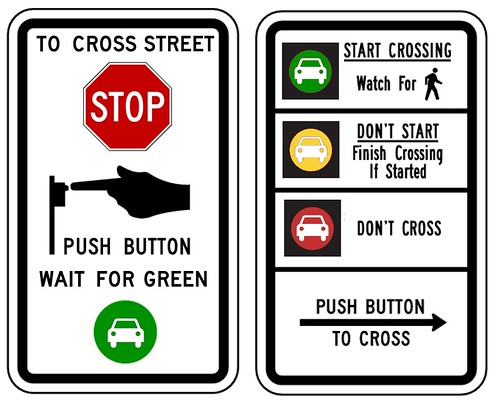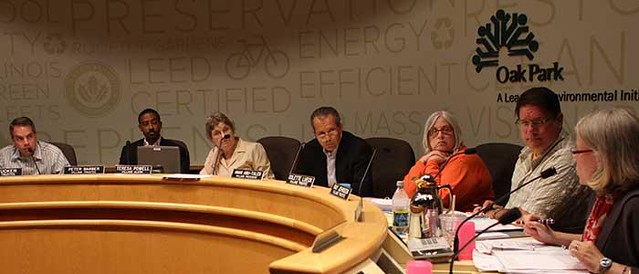The walls of the Oak Park Village Board’s chambers are emblazoned with environmental buzzwords like “Bicycle Friendly,” “Mass Transit,” “LEED Certified,” “Energy Efficient,” and "Clean Air." So it’s pretty ironic that the board recently voted, in that very room, to make walking harder in order to make driving easier.
Back in 2011, the suburb did the right thing by removing existing walk-signal request buttons at major intersections along Lake Street. Push buttons that make a walk signal appear faster – similar to “induction loops” in the pavement that tell a stoplight when a driver is waiting – are a good thing. But when pushing a button is the only way to get a walk signal at all, as was the case on Lake, the device is disparagingly known as a “beg button,” because it requires pedestrians to ask for permission to cross the street.
Beg buttons are problematic in a number of ways. Unless someone has pushed the button before you arrive at an intersection, you will always have to wait at least a moment before being given the opportunity to cross. If you fail to notice the button, you may wait in vain for a walk signal for a cycle or two before you realize what’s going on. And, since the main purpose of beg buttons is to maximize the length of the green phase for drivers, they send the message that pedestrians are tolerated on the public way, but the real purpose of streets is to move cars.
That’s basically the statement that the village board made yesterday when they voted to reinstall the beg buttons on Lake between Marion Street and Oak Park Avenue. At the meeting, acting village engineer Bill McKenna told the board that bringing back the beg buttons would “decrease traffic congestion,” the Chicago Tribune reported.

McKenna noted that, with the current signal phasing, there’s a walk signal phase whether or not a pedestrian is present. "Right now, at 2 a.m., it's assuming there's a pedestrian," he said. Of course there’s little traffic congestion late at night, and plenty of pedestrians need to cross Lake during rush hours, since the street runs between local train stations and business districts.
It appears that McKenna is less interested in decreasing congestion than mitigating drivers’ frustration at having to wait for “unnecessary” reds. Never mind that pedestrians are also required to wait for stoplights at all hours of the day, whether or not cars are present.
After hearing McKenna’s testimony, the board voted in favor of bringing back the beg buttons. On the plus side, they also voted to upgrade walk signals at Marion, Oak Park, Forest and Kenilworth avenues to pedestrian countdown signals, which will increase pedestrian safety and comfort by letting people on foot know how much time they have left to cross. The total price tag for both projects is about $19,500.
Active Transportation Alliance director and Oak Park resident Ron Burke said he’s bummed about the decision to reinstall the buttons. “It’s a disappointing change,” he said. “We don’t support this approach, as it’s not pedestrian-friendly.”
“I hate beg buttons,” commented Streetsblog reader Elliot Mason in the wake of the news. “If your lights are timed properly there are pedestrian walk signals regularly and beg buttons are superfluous. Having grown up in Chicago, they just scream ‘suburbs’ and ‘cars first’ to me.”





